Healthcare: Interprofessional Learning and Obesity in Haringey
VerifiedAdded on 2023/03/23
|15
|4134
|54
Essay
AI Summary
This essay delves into the pressing issue of childhood obesity within the London Borough of Haringey, highlighting it as a significant public health concern. The introduction establishes the severity of obesity, its associated health risks, and the economic burden it places on the NHS. The essay explores key variables influencing health in Haringey, including environmental, behavioral, and socioeconomic factors, as well as the inequalities that exacerbate the problem. It also identifies the challenges faced in tackling obesity, such as the lack of free exercise spaces, the complexity of intervention development, and unhealthy eating habits. The essay then details the interventions currently implemented in Haringey, such as healthy nutrition programs, exercise initiatives, and health promotion activities. The concept of interprofessional working is then introduced as a collaborative approach involving various healthcare professionals to improve health outcomes. The essay analyzes the advantages and disadvantages of interprofessional working, including improved communication, client-centered care, and career development, alongside complexities in coordination and leadership. Finally, the essay examines national policies supporting interprofessional working, such as the health and social care integration policy.

Running head: Healthcare
INTER-PROFESSIONAL LEARNING
By (Student's Name)
Class
Teacher
Name of the School
City
Date
INTER-PROFESSIONAL LEARNING
By (Student's Name)
Class
Teacher
Name of the School
City
Date
Paraphrase This Document
Need a fresh take? Get an instant paraphrase of this document with our AI Paraphraser
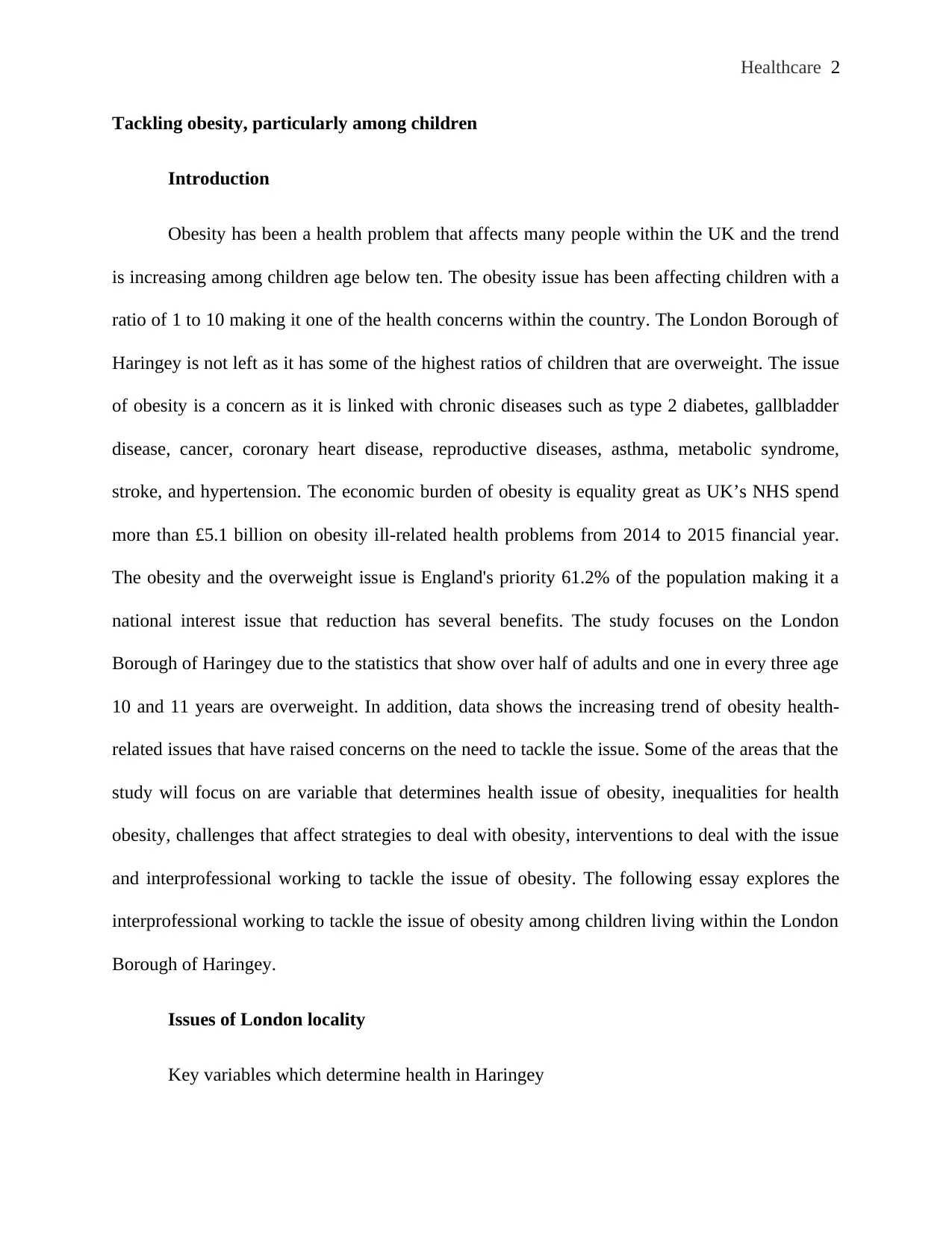
Healthcare 2
Tackling obesity, particularly among children
Introduction
Obesity has been a health problem that affects many people within the UK and the trend
is increasing among children age below ten. The obesity issue has been affecting children with a
ratio of 1 to 10 making it one of the health concerns within the country. The London Borough of
Haringey is not left as it has some of the highest ratios of children that are overweight. The issue
of obesity is a concern as it is linked with chronic diseases such as type 2 diabetes, gallbladder
disease, cancer, coronary heart disease, reproductive diseases, asthma, metabolic syndrome,
stroke, and hypertension. The economic burden of obesity is equality great as UK’s NHS spend
more than £5.1 billion on obesity ill-related health problems from 2014 to 2015 financial year.
The obesity and the overweight issue is England's priority 61.2% of the population making it a
national interest issue that reduction has several benefits. The study focuses on the London
Borough of Haringey due to the statistics that show over half of adults and one in every three age
10 and 11 years are overweight. In addition, data shows the increasing trend of obesity health-
related issues that have raised concerns on the need to tackle the issue. Some of the areas that the
study will focus on are variable that determines health issue of obesity, inequalities for health
obesity, challenges that affect strategies to deal with obesity, interventions to deal with the issue
and interprofessional working to tackle the issue of obesity. The following essay explores the
interprofessional working to tackle the issue of obesity among children living within the London
Borough of Haringey.
Issues of London locality
Key variables which determine health in Haringey
Tackling obesity, particularly among children
Introduction
Obesity has been a health problem that affects many people within the UK and the trend
is increasing among children age below ten. The obesity issue has been affecting children with a
ratio of 1 to 10 making it one of the health concerns within the country. The London Borough of
Haringey is not left as it has some of the highest ratios of children that are overweight. The issue
of obesity is a concern as it is linked with chronic diseases such as type 2 diabetes, gallbladder
disease, cancer, coronary heart disease, reproductive diseases, asthma, metabolic syndrome,
stroke, and hypertension. The economic burden of obesity is equality great as UK’s NHS spend
more than £5.1 billion on obesity ill-related health problems from 2014 to 2015 financial year.
The obesity and the overweight issue is England's priority 61.2% of the population making it a
national interest issue that reduction has several benefits. The study focuses on the London
Borough of Haringey due to the statistics that show over half of adults and one in every three age
10 and 11 years are overweight. In addition, data shows the increasing trend of obesity health-
related issues that have raised concerns on the need to tackle the issue. Some of the areas that the
study will focus on are variable that determines health issue of obesity, inequalities for health
obesity, challenges that affect strategies to deal with obesity, interventions to deal with the issue
and interprofessional working to tackle the issue of obesity. The following essay explores the
interprofessional working to tackle the issue of obesity among children living within the London
Borough of Haringey.
Issues of London locality
Key variables which determine health in Haringey
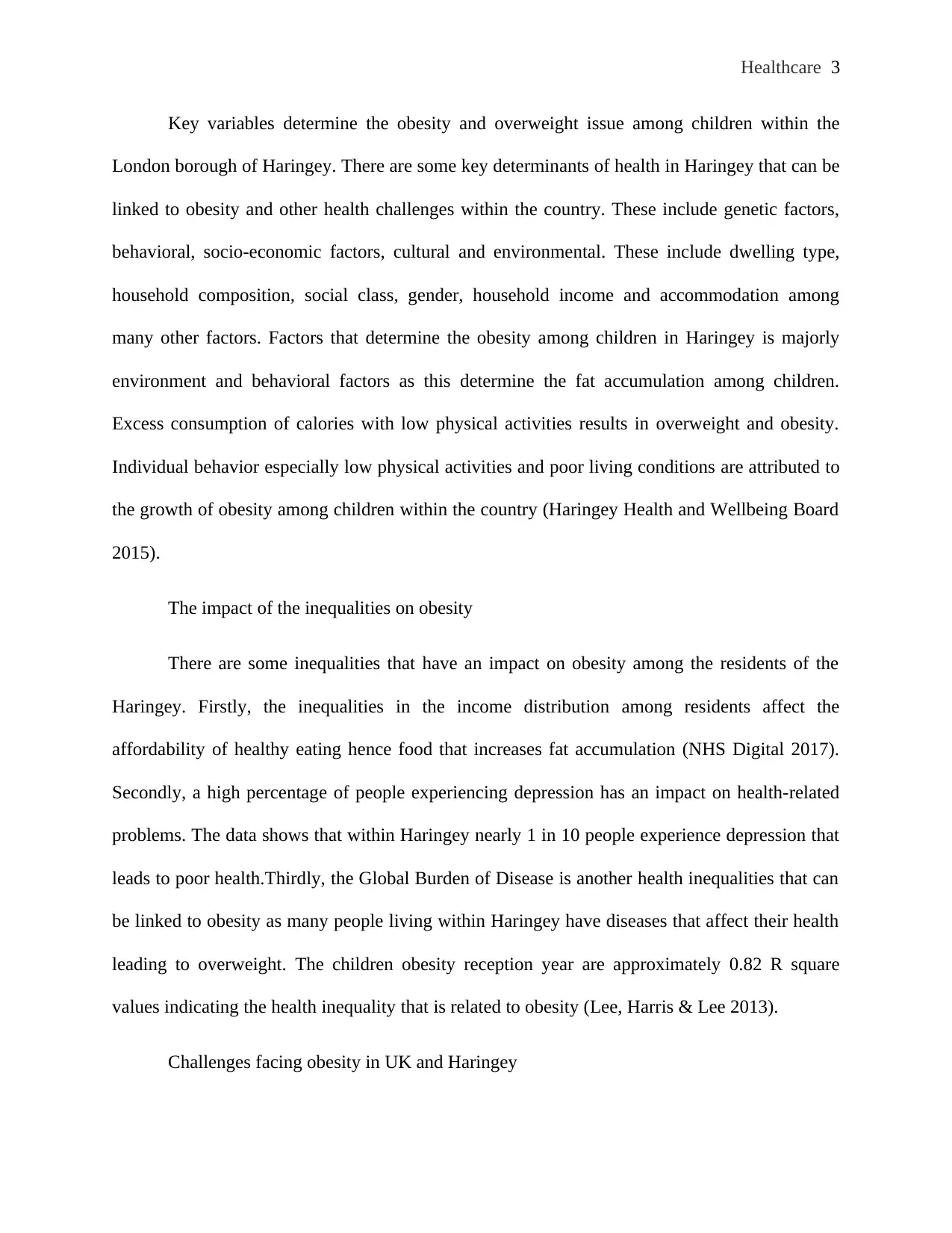
Healthcare 3
Key variables determine the obesity and overweight issue among children within the
London borough of Haringey. There are some key determinants of health in Haringey that can be
linked to obesity and other health challenges within the country. These include genetic factors,
behavioral, socio-economic factors, cultural and environmental. These include dwelling type,
household composition, social class, gender, household income and accommodation among
many other factors. Factors that determine the obesity among children in Haringey is majorly
environment and behavioral factors as this determine the fat accumulation among children.
Excess consumption of calories with low physical activities results in overweight and obesity.
Individual behavior especially low physical activities and poor living conditions are attributed to
the growth of obesity among children within the country (Haringey Health and Wellbeing Board
2015).
The impact of the inequalities on obesity
There are some inequalities that have an impact on obesity among the residents of the
Haringey. Firstly, the inequalities in the income distribution among residents affect the
affordability of healthy eating hence food that increases fat accumulation (NHS Digital 2017).
Secondly, a high percentage of people experiencing depression has an impact on health-related
problems. The data shows that within Haringey nearly 1 in 10 people experience depression that
leads to poor health.Thirdly, the Global Burden of Disease is another health inequalities that can
be linked to obesity as many people living within Haringey have diseases that affect their health
leading to overweight. The children obesity reception year are approximately 0.82 R square
values indicating the health inequality that is related to obesity (Lee, Harris & Lee 2013).
Challenges facing obesity in UK and Haringey
Key variables determine the obesity and overweight issue among children within the
London borough of Haringey. There are some key determinants of health in Haringey that can be
linked to obesity and other health challenges within the country. These include genetic factors,
behavioral, socio-economic factors, cultural and environmental. These include dwelling type,
household composition, social class, gender, household income and accommodation among
many other factors. Factors that determine the obesity among children in Haringey is majorly
environment and behavioral factors as this determine the fat accumulation among children.
Excess consumption of calories with low physical activities results in overweight and obesity.
Individual behavior especially low physical activities and poor living conditions are attributed to
the growth of obesity among children within the country (Haringey Health and Wellbeing Board
2015).
The impact of the inequalities on obesity
There are some inequalities that have an impact on obesity among the residents of the
Haringey. Firstly, the inequalities in the income distribution among residents affect the
affordability of healthy eating hence food that increases fat accumulation (NHS Digital 2017).
Secondly, a high percentage of people experiencing depression has an impact on health-related
problems. The data shows that within Haringey nearly 1 in 10 people experience depression that
leads to poor health.Thirdly, the Global Burden of Disease is another health inequalities that can
be linked to obesity as many people living within Haringey have diseases that affect their health
leading to overweight. The children obesity reception year are approximately 0.82 R square
values indicating the health inequality that is related to obesity (Lee, Harris & Lee 2013).
Challenges facing obesity in UK and Haringey
⊘ This is a preview!⊘
Do you want full access?
Subscribe today to unlock all pages.

Trusted by 1+ million students worldwide
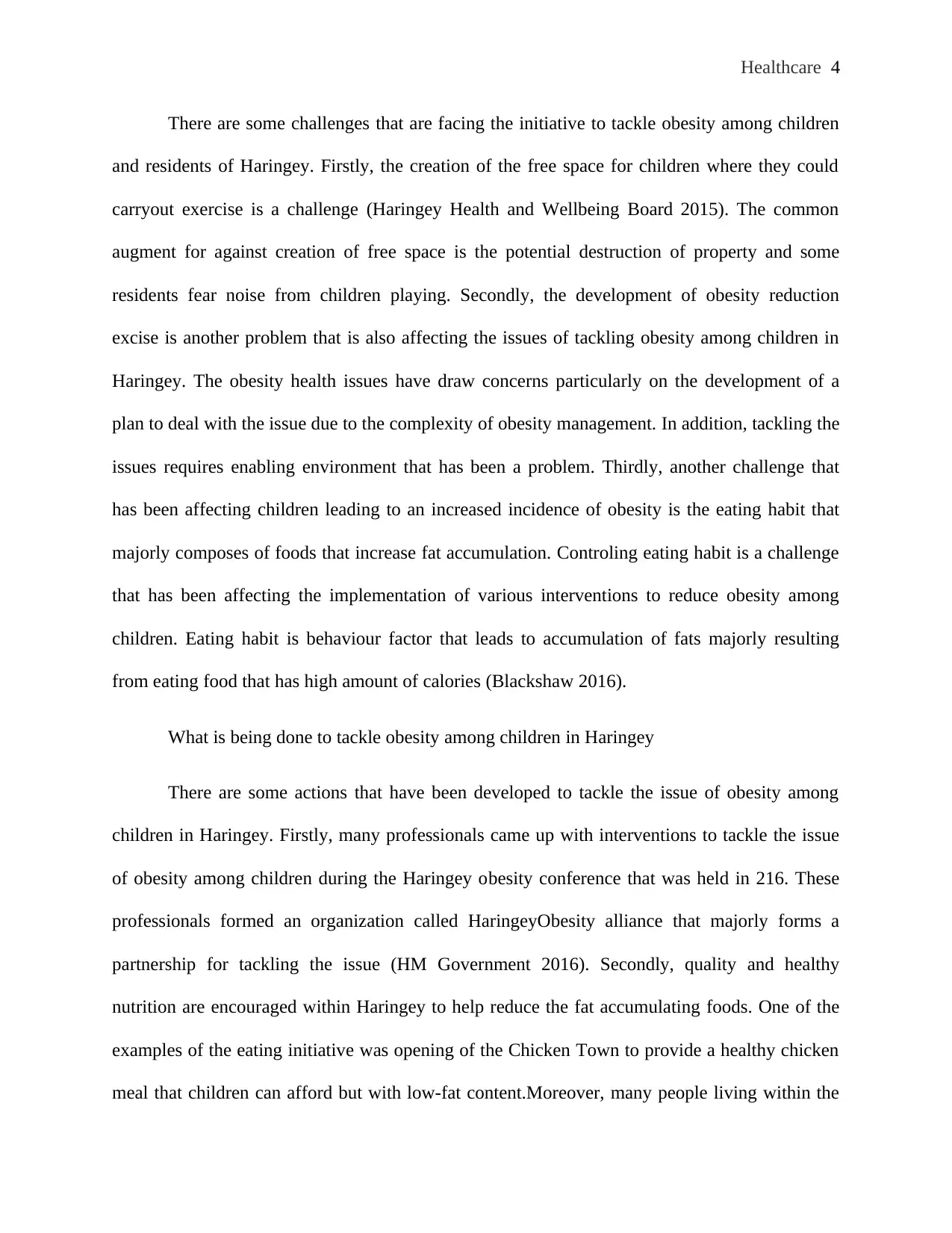
Healthcare 4
There are some challenges that are facing the initiative to tackle obesity among children
and residents of Haringey. Firstly, the creation of the free space for children where they could
carryout exercise is a challenge (Haringey Health and Wellbeing Board 2015). The common
augment for against creation of free space is the potential destruction of property and some
residents fear noise from children playing. Secondly, the development of obesity reduction
excise is another problem that is also affecting the issues of tackling obesity among children in
Haringey. The obesity health issues have draw concerns particularly on the development of a
plan to deal with the issue due to the complexity of obesity management. In addition, tackling the
issues requires enabling environment that has been a problem. Thirdly, another challenge that
has been affecting children leading to an increased incidence of obesity is the eating habit that
majorly composes of foods that increase fat accumulation. Controling eating habit is a challenge
that has been affecting the implementation of various interventions to reduce obesity among
children. Eating habit is behaviour factor that leads to accumulation of fats majorly resulting
from eating food that has high amount of calories (Blackshaw 2016).
What is being done to tackle obesity among children in Haringey
There are some actions that have been developed to tackle the issue of obesity among
children in Haringey. Firstly, many professionals came up with interventions to tackle the issue
of obesity among children during the Haringey obesity conference that was held in 216. These
professionals formed an organization called HaringeyObesity alliance that majorly forms a
partnership for tackling the issue (HM Government 2016). Secondly, quality and healthy
nutrition are encouraged within Haringey to help reduce the fat accumulating foods. One of the
examples of the eating initiative was opening of the Chicken Town to provide a healthy chicken
meal that children can afford but with low-fat content.Moreover, many people living within the
There are some challenges that are facing the initiative to tackle obesity among children
and residents of Haringey. Firstly, the creation of the free space for children where they could
carryout exercise is a challenge (Haringey Health and Wellbeing Board 2015). The common
augment for against creation of free space is the potential destruction of property and some
residents fear noise from children playing. Secondly, the development of obesity reduction
excise is another problem that is also affecting the issues of tackling obesity among children in
Haringey. The obesity health issues have draw concerns particularly on the development of a
plan to deal with the issue due to the complexity of obesity management. In addition, tackling the
issues requires enabling environment that has been a problem. Thirdly, another challenge that
has been affecting children leading to an increased incidence of obesity is the eating habit that
majorly composes of foods that increase fat accumulation. Controling eating habit is a challenge
that has been affecting the implementation of various interventions to reduce obesity among
children. Eating habit is behaviour factor that leads to accumulation of fats majorly resulting
from eating food that has high amount of calories (Blackshaw 2016).
What is being done to tackle obesity among children in Haringey
There are some actions that have been developed to tackle the issue of obesity among
children in Haringey. Firstly, many professionals came up with interventions to tackle the issue
of obesity among children during the Haringey obesity conference that was held in 216. These
professionals formed an organization called HaringeyObesity alliance that majorly forms a
partnership for tackling the issue (HM Government 2016). Secondly, quality and healthy
nutrition are encouraged within Haringey to help reduce the fat accumulating foods. One of the
examples of the eating initiative was opening of the Chicken Town to provide a healthy chicken
meal that children can afford but with low-fat content.Moreover, many people living within the
Paraphrase This Document
Need a fresh take? Get an instant paraphrase of this document with our AI Paraphraser
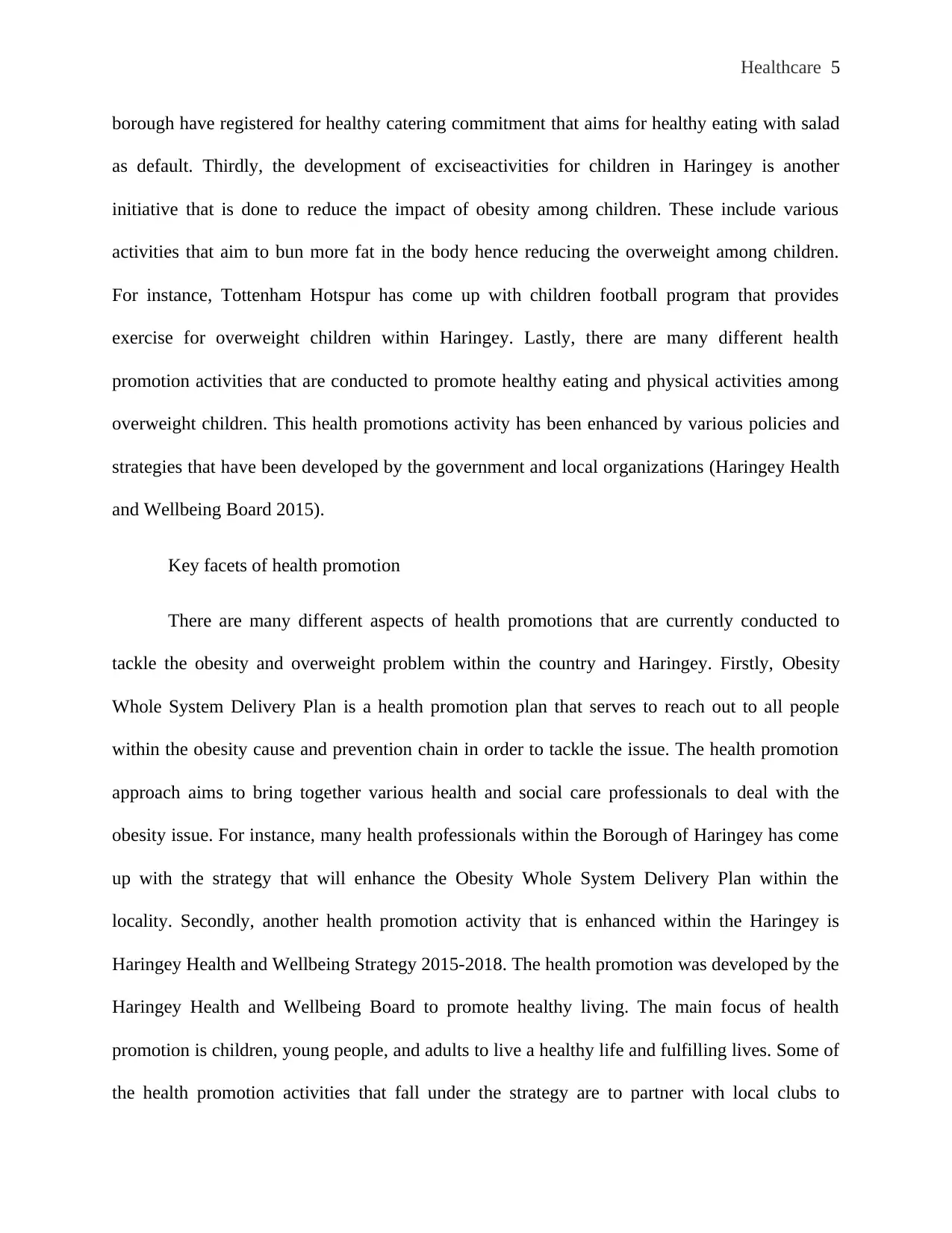
Healthcare 5
borough have registered for healthy catering commitment that aims for healthy eating with salad
as default. Thirdly, the development of exciseactivities for children in Haringey is another
initiative that is done to reduce the impact of obesity among children. These include various
activities that aim to bun more fat in the body hence reducing the overweight among children.
For instance, Tottenham Hotspur has come up with children football program that provides
exercise for overweight children within Haringey. Lastly, there are many different health
promotion activities that are conducted to promote healthy eating and physical activities among
overweight children. This health promotions activity has been enhanced by various policies and
strategies that have been developed by the government and local organizations (Haringey Health
and Wellbeing Board 2015).
Key facets of health promotion
There are many different aspects of health promotions that are currently conducted to
tackle the obesity and overweight problem within the country and Haringey. Firstly, Obesity
Whole System Delivery Plan is a health promotion plan that serves to reach out to all people
within the obesity cause and prevention chain in order to tackle the issue. The health promotion
approach aims to bring together various health and social care professionals to deal with the
obesity issue. For instance, many health professionals within the Borough of Haringey has come
up with the strategy that will enhance the Obesity Whole System Delivery Plan within the
locality. Secondly, another health promotion activity that is enhanced within the Haringey is
Haringey Health and Wellbeing Strategy 2015-2018. The health promotion was developed by the
Haringey Health and Wellbeing Board to promote healthy living. The main focus of health
promotion is children, young people, and adults to live a healthy life and fulfilling lives. Some of
the health promotion activities that fall under the strategy are to partner with local clubs to
borough have registered for healthy catering commitment that aims for healthy eating with salad
as default. Thirdly, the development of exciseactivities for children in Haringey is another
initiative that is done to reduce the impact of obesity among children. These include various
activities that aim to bun more fat in the body hence reducing the overweight among children.
For instance, Tottenham Hotspur has come up with children football program that provides
exercise for overweight children within Haringey. Lastly, there are many different health
promotion activities that are conducted to promote healthy eating and physical activities among
overweight children. This health promotions activity has been enhanced by various policies and
strategies that have been developed by the government and local organizations (Haringey Health
and Wellbeing Board 2015).
Key facets of health promotion
There are many different aspects of health promotions that are currently conducted to
tackle the obesity and overweight problem within the country and Haringey. Firstly, Obesity
Whole System Delivery Plan is a health promotion plan that serves to reach out to all people
within the obesity cause and prevention chain in order to tackle the issue. The health promotion
approach aims to bring together various health and social care professionals to deal with the
obesity issue. For instance, many health professionals within the Borough of Haringey has come
up with the strategy that will enhance the Obesity Whole System Delivery Plan within the
locality. Secondly, another health promotion activity that is enhanced within the Haringey is
Haringey Health and Wellbeing Strategy 2015-2018. The health promotion was developed by the
Haringey Health and Wellbeing Board to promote healthy living. The main focus of health
promotion is children, young people, and adults to live a healthy life and fulfilling lives. Some of
the health promotion activities that fall under the strategy are to partner with local clubs to
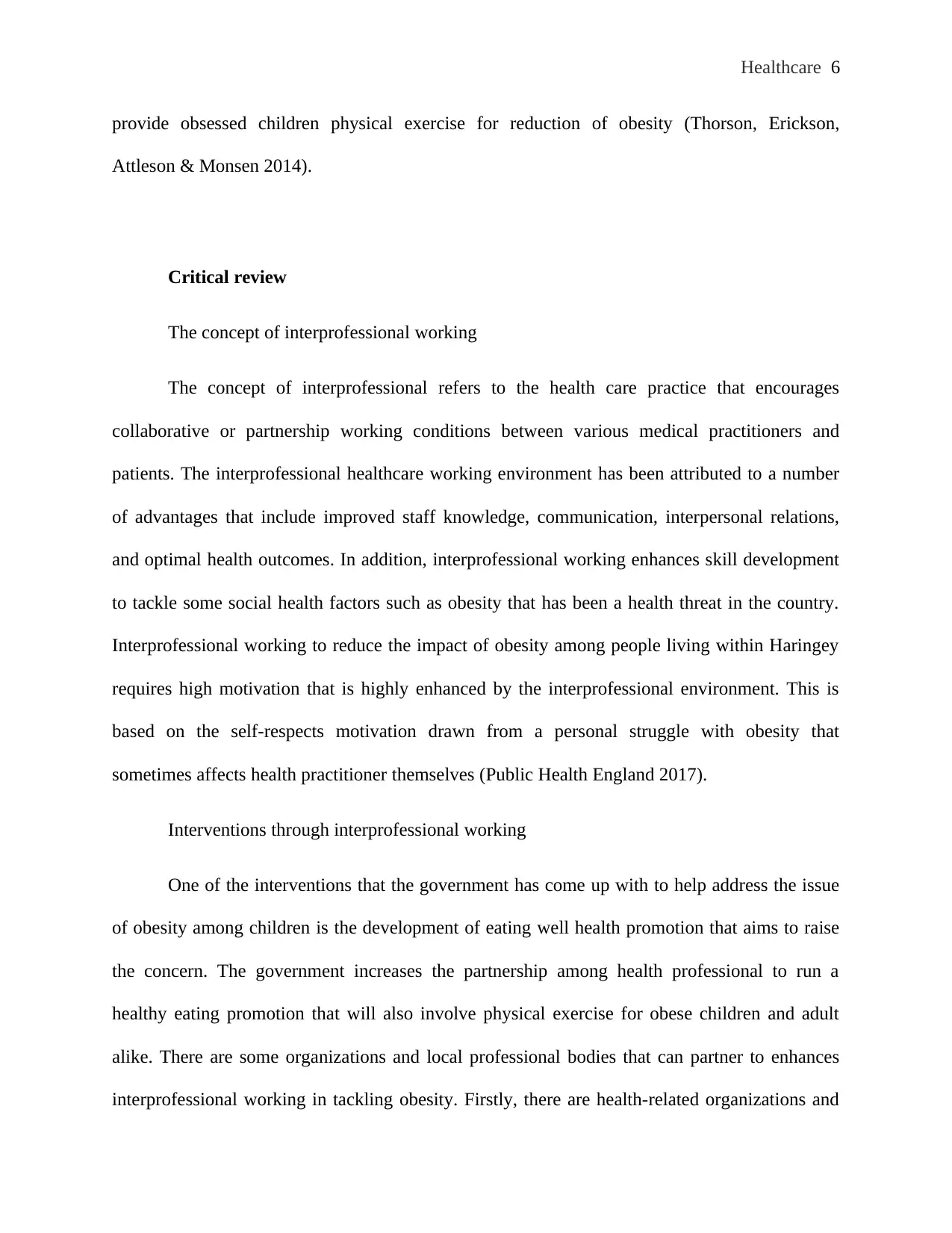
Healthcare 6
provide obsessed children physical exercise for reduction of obesity (Thorson, Erickson,
Attleson & Monsen 2014).
Critical review
The concept of interprofessional working
The concept of interprofessional refers to the health care practice that encourages
collaborative or partnership working conditions between various medical practitioners and
patients. The interprofessional healthcare working environment has been attributed to a number
of advantages that include improved staff knowledge, communication, interpersonal relations,
and optimal health outcomes. In addition, interprofessional working enhances skill development
to tackle some social health factors such as obesity that has been a health threat in the country.
Interprofessional working to reduce the impact of obesity among people living within Haringey
requires high motivation that is highly enhanced by the interprofessional environment. This is
based on the self-respects motivation drawn from a personal struggle with obesity that
sometimes affects health practitioner themselves (Public Health England 2017).
Interventions through interprofessional working
One of the interventions that the government has come up with to help address the issue
of obesity among children is the development of eating well health promotion that aims to raise
the concern. The government increases the partnership among health professional to run a
healthy eating promotion that will also involve physical exercise for obese children and adult
alike. There are some organizations and local professional bodies that can partner to enhances
interprofessional working in tackling obesity. Firstly, there are health-related organizations and
provide obsessed children physical exercise for reduction of obesity (Thorson, Erickson,
Attleson & Monsen 2014).
Critical review
The concept of interprofessional working
The concept of interprofessional refers to the health care practice that encourages
collaborative or partnership working conditions between various medical practitioners and
patients. The interprofessional healthcare working environment has been attributed to a number
of advantages that include improved staff knowledge, communication, interpersonal relations,
and optimal health outcomes. In addition, interprofessional working enhances skill development
to tackle some social health factors such as obesity that has been a health threat in the country.
Interprofessional working to reduce the impact of obesity among people living within Haringey
requires high motivation that is highly enhanced by the interprofessional environment. This is
based on the self-respects motivation drawn from a personal struggle with obesity that
sometimes affects health practitioner themselves (Public Health England 2017).
Interventions through interprofessional working
One of the interventions that the government has come up with to help address the issue
of obesity among children is the development of eating well health promotion that aims to raise
the concern. The government increases the partnership among health professional to run a
healthy eating promotion that will also involve physical exercise for obese children and adult
alike. There are some organizations and local professional bodies that can partner to enhances
interprofessional working in tackling obesity. Firstly, there are health-related organizations and
⊘ This is a preview!⊘
Do you want full access?
Subscribe today to unlock all pages.

Trusted by 1+ million students worldwide
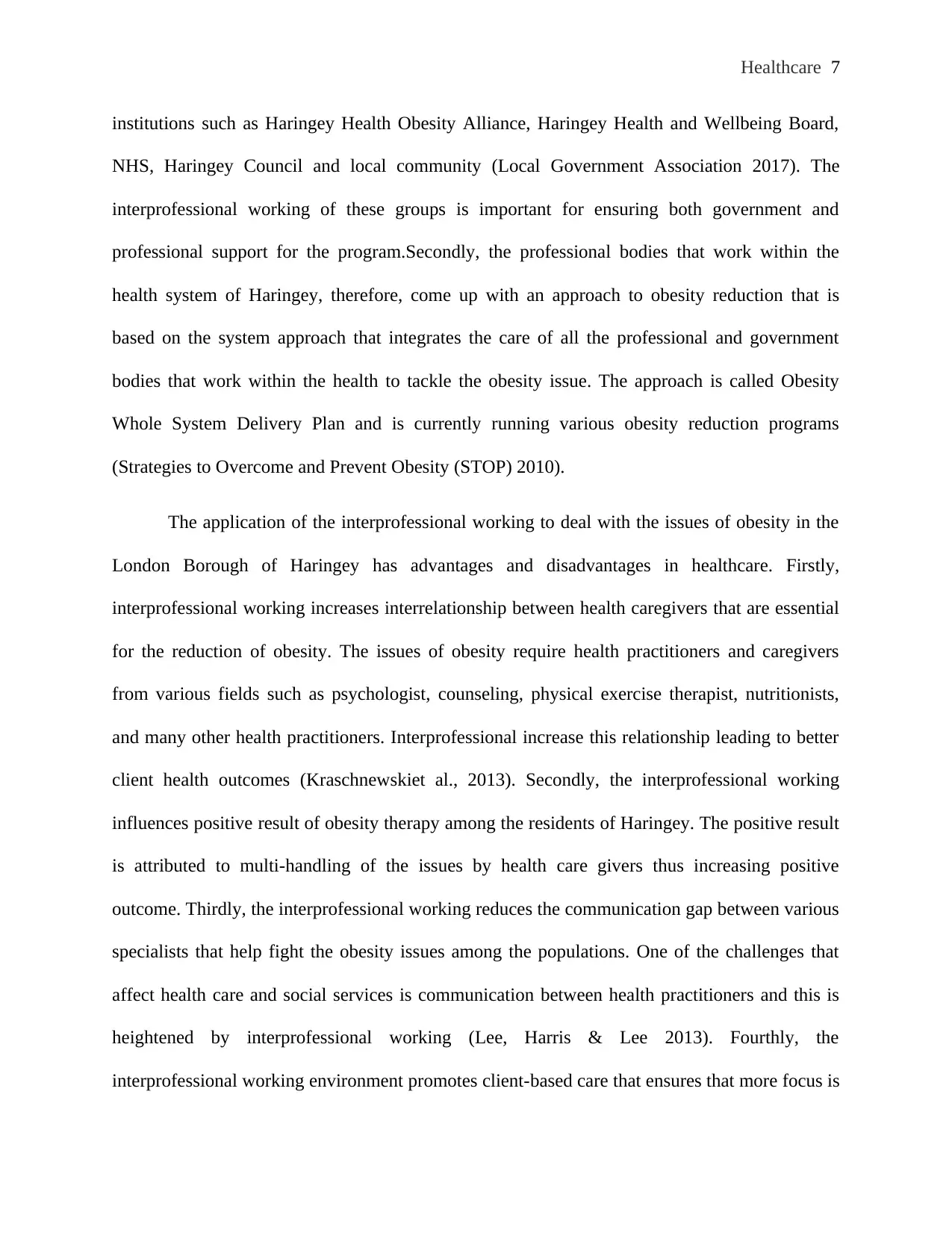
Healthcare 7
institutions such as Haringey Health Obesity Alliance, Haringey Health and Wellbeing Board,
NHS, Haringey Council and local community (Local Government Association 2017). The
interprofessional working of these groups is important for ensuring both government and
professional support for the program.Secondly, the professional bodies that work within the
health system of Haringey, therefore, come up with an approach to obesity reduction that is
based on the system approach that integrates the care of all the professional and government
bodies that work within the health to tackle the obesity issue. The approach is called Obesity
Whole System Delivery Plan and is currently running various obesity reduction programs
(Strategies to Overcome and Prevent Obesity (STOP) 2010).
The application of the interprofessional working to deal with the issues of obesity in the
London Borough of Haringey has advantages and disadvantages in healthcare. Firstly,
interprofessional working increases interrelationship between health caregivers that are essential
for the reduction of obesity. The issues of obesity require health practitioners and caregivers
from various fields such as psychologist, counseling, physical exercise therapist, nutritionists,
and many other health practitioners. Interprofessional increase this relationship leading to better
client health outcomes (Kraschnewskiet al., 2013). Secondly, the interprofessional working
influences positive result of obesity therapy among the residents of Haringey. The positive result
is attributed to multi-handling of the issues by health care givers thus increasing positive
outcome. Thirdly, the interprofessional working reduces the communication gap between various
specialists that help fight the obesity issues among the populations. One of the challenges that
affect health care and social services is communication between health practitioners and this is
heightened by interprofessional working (Lee, Harris & Lee 2013). Fourthly, the
interprofessional working environment promotes client-based care that ensures that more focus is
institutions such as Haringey Health Obesity Alliance, Haringey Health and Wellbeing Board,
NHS, Haringey Council and local community (Local Government Association 2017). The
interprofessional working of these groups is important for ensuring both government and
professional support for the program.Secondly, the professional bodies that work within the
health system of Haringey, therefore, come up with an approach to obesity reduction that is
based on the system approach that integrates the care of all the professional and government
bodies that work within the health to tackle the obesity issue. The approach is called Obesity
Whole System Delivery Plan and is currently running various obesity reduction programs
(Strategies to Overcome and Prevent Obesity (STOP) 2010).
The application of the interprofessional working to deal with the issues of obesity in the
London Borough of Haringey has advantages and disadvantages in healthcare. Firstly,
interprofessional working increases interrelationship between health caregivers that are essential
for the reduction of obesity. The issues of obesity require health practitioners and caregivers
from various fields such as psychologist, counseling, physical exercise therapist, nutritionists,
and many other health practitioners. Interprofessional increase this relationship leading to better
client health outcomes (Kraschnewskiet al., 2013). Secondly, the interprofessional working
influences positive result of obesity therapy among the residents of Haringey. The positive result
is attributed to multi-handling of the issues by health care givers thus increasing positive
outcome. Thirdly, the interprofessional working reduces the communication gap between various
specialists that help fight the obesity issues among the populations. One of the challenges that
affect health care and social services is communication between health practitioners and this is
heightened by interprofessional working (Lee, Harris & Lee 2013). Fourthly, the
interprofessional working environment promotes client-based care that ensures that more focus is
Paraphrase This Document
Need a fresh take? Get an instant paraphrase of this document with our AI Paraphraser
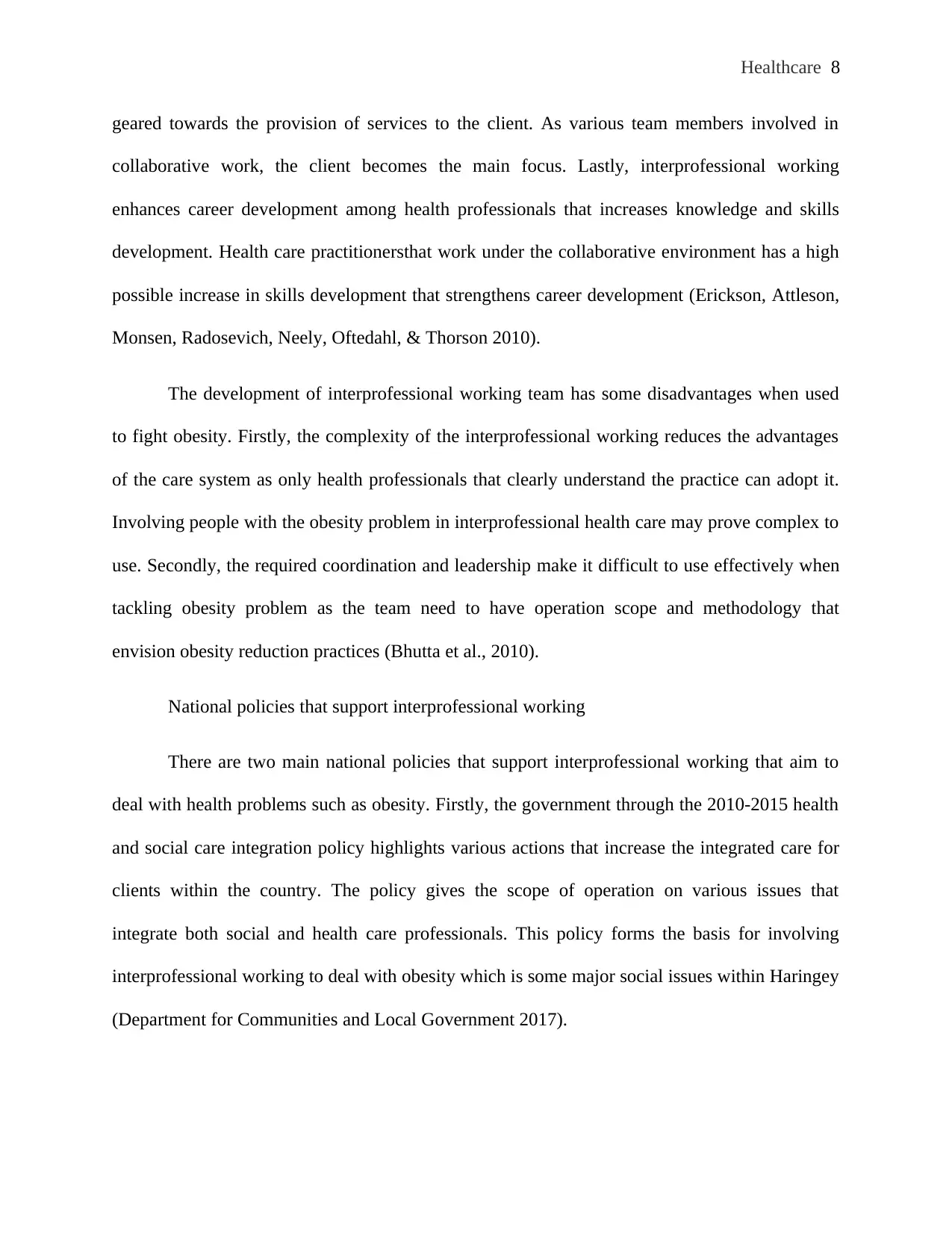
Healthcare 8
geared towards the provision of services to the client. As various team members involved in
collaborative work, the client becomes the main focus. Lastly, interprofessional working
enhances career development among health professionals that increases knowledge and skills
development. Health care practitionersthat work under the collaborative environment has a high
possible increase in skills development that strengthens career development (Erickson, Attleson,
Monsen, Radosevich, Neely, Oftedahl, & Thorson 2010).
The development of interprofessional working team has some disadvantages when used
to fight obesity. Firstly, the complexity of the interprofessional working reduces the advantages
of the care system as only health professionals that clearly understand the practice can adopt it.
Involving people with the obesity problem in interprofessional health care may prove complex to
use. Secondly, the required coordination and leadership make it difficult to use effectively when
tackling obesity problem as the team need to have operation scope and methodology that
envision obesity reduction practices (Bhutta et al., 2010).
National policies that support interprofessional working
There are two main national policies that support interprofessional working that aim to
deal with health problems such as obesity. Firstly, the government through the 2010-2015 health
and social care integration policy highlights various actions that increase the integrated care for
clients within the country. The policy gives the scope of operation on various issues that
integrate both social and health care professionals. This policy forms the basis for involving
interprofessional working to deal with obesity which is some major social issues within Haringey
(Department for Communities and Local Government 2017).
geared towards the provision of services to the client. As various team members involved in
collaborative work, the client becomes the main focus. Lastly, interprofessional working
enhances career development among health professionals that increases knowledge and skills
development. Health care practitionersthat work under the collaborative environment has a high
possible increase in skills development that strengthens career development (Erickson, Attleson,
Monsen, Radosevich, Neely, Oftedahl, & Thorson 2010).
The development of interprofessional working team has some disadvantages when used
to fight obesity. Firstly, the complexity of the interprofessional working reduces the advantages
of the care system as only health professionals that clearly understand the practice can adopt it.
Involving people with the obesity problem in interprofessional health care may prove complex to
use. Secondly, the required coordination and leadership make it difficult to use effectively when
tackling obesity problem as the team need to have operation scope and methodology that
envision obesity reduction practices (Bhutta et al., 2010).
National policies that support interprofessional working
There are two main national policies that support interprofessional working that aim to
deal with health problems such as obesity. Firstly, the government through the 2010-2015 health
and social care integration policy highlights various actions that increase the integrated care for
clients within the country. The policy gives the scope of operation on various issues that
integrate both social and health care professionals. This policy forms the basis for involving
interprofessional working to deal with obesity which is some major social issues within Haringey
(Department for Communities and Local Government 2017).
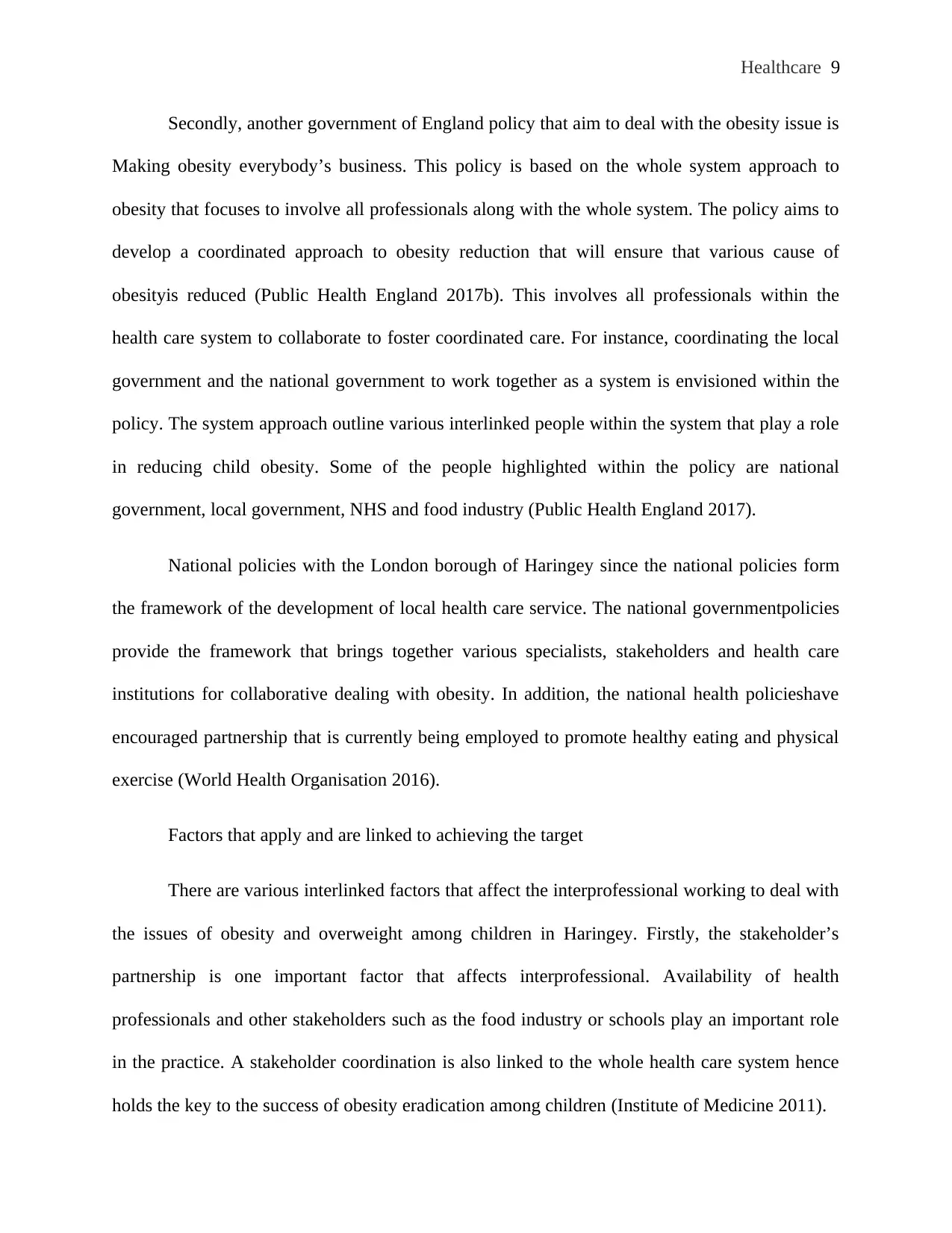
Healthcare 9
Secondly, another government of England policy that aim to deal with the obesity issue is
Making obesity everybody’s business. This policy is based on the whole system approach to
obesity that focuses to involve all professionals along with the whole system. The policy aims to
develop a coordinated approach to obesity reduction that will ensure that various cause of
obesityis reduced (Public Health England 2017b). This involves all professionals within the
health care system to collaborate to foster coordinated care. For instance, coordinating the local
government and the national government to work together as a system is envisioned within the
policy. The system approach outline various interlinked people within the system that play a role
in reducing child obesity. Some of the people highlighted within the policy are national
government, local government, NHS and food industry (Public Health England 2017).
National policies with the London borough of Haringey since the national policies form
the framework of the development of local health care service. The national governmentpolicies
provide the framework that brings together various specialists, stakeholders and health care
institutions for collaborative dealing with obesity. In addition, the national health policieshave
encouraged partnership that is currently being employed to promote healthy eating and physical
exercise (World Health Organisation 2016).
Factors that apply and are linked to achieving the target
There are various interlinked factors that affect the interprofessional working to deal with
the issues of obesity and overweight among children in Haringey. Firstly, the stakeholder’s
partnership is one important factor that affects interprofessional. Availability of health
professionals and other stakeholders such as the food industry or schools play an important role
in the practice. A stakeholder coordination is also linked to the whole health care system hence
holds the key to the success of obesity eradication among children (Institute of Medicine 2011).
Secondly, another government of England policy that aim to deal with the obesity issue is
Making obesity everybody’s business. This policy is based on the whole system approach to
obesity that focuses to involve all professionals along with the whole system. The policy aims to
develop a coordinated approach to obesity reduction that will ensure that various cause of
obesityis reduced (Public Health England 2017b). This involves all professionals within the
health care system to collaborate to foster coordinated care. For instance, coordinating the local
government and the national government to work together as a system is envisioned within the
policy. The system approach outline various interlinked people within the system that play a role
in reducing child obesity. Some of the people highlighted within the policy are national
government, local government, NHS and food industry (Public Health England 2017).
National policies with the London borough of Haringey since the national policies form
the framework of the development of local health care service. The national governmentpolicies
provide the framework that brings together various specialists, stakeholders and health care
institutions for collaborative dealing with obesity. In addition, the national health policieshave
encouraged partnership that is currently being employed to promote healthy eating and physical
exercise (World Health Organisation 2016).
Factors that apply and are linked to achieving the target
There are various interlinked factors that affect the interprofessional working to deal with
the issues of obesity and overweight among children in Haringey. Firstly, the stakeholder’s
partnership is one important factor that affects interprofessional. Availability of health
professionals and other stakeholders such as the food industry or schools play an important role
in the practice. A stakeholder coordination is also linked to the whole health care system hence
holds the key to the success of obesity eradication among children (Institute of Medicine 2011).
⊘ This is a preview!⊘
Do you want full access?
Subscribe today to unlock all pages.

Trusted by 1+ million students worldwide
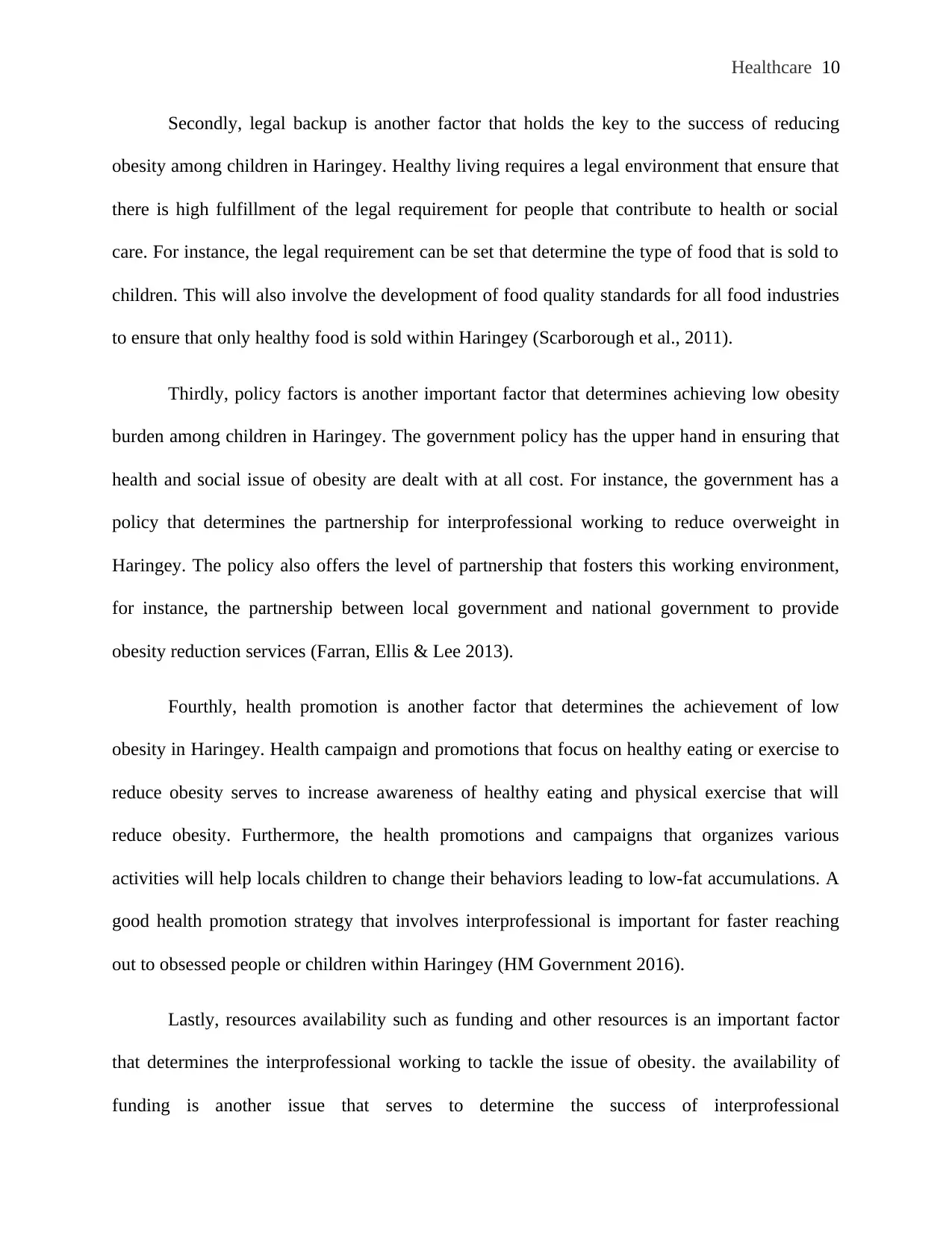
Healthcare 10
Secondly, legal backup is another factor that holds the key to the success of reducing
obesity among children in Haringey. Healthy living requires a legal environment that ensure that
there is high fulfillment of the legal requirement for people that contribute to health or social
care. For instance, the legal requirement can be set that determine the type of food that is sold to
children. This will also involve the development of food quality standards for all food industries
to ensure that only healthy food is sold within Haringey (Scarborough et al., 2011).
Thirdly, policy factors is another important factor that determines achieving low obesity
burden among children in Haringey. The government policy has the upper hand in ensuring that
health and social issue of obesity are dealt with at all cost. For instance, the government has a
policy that determines the partnership for interprofessional working to reduce overweight in
Haringey. The policy also offers the level of partnership that fosters this working environment,
for instance, the partnership between local government and national government to provide
obesity reduction services (Farran, Ellis & Lee 2013).
Fourthly, health promotion is another factor that determines the achievement of low
obesity in Haringey. Health campaign and promotions that focus on healthy eating or exercise to
reduce obesity serves to increase awareness of healthy eating and physical exercise that will
reduce obesity. Furthermore, the health promotions and campaigns that organizes various
activities will help locals children to change their behaviors leading to low-fat accumulations. A
good health promotion strategy that involves interprofessional is important for faster reaching
out to obsessed people or children within Haringey (HM Government 2016).
Lastly, resources availability such as funding and other resources is an important factor
that determines the interprofessional working to tackle the issue of obesity. the availability of
funding is another issue that serves to determine the success of interprofessional
Secondly, legal backup is another factor that holds the key to the success of reducing
obesity among children in Haringey. Healthy living requires a legal environment that ensure that
there is high fulfillment of the legal requirement for people that contribute to health or social
care. For instance, the legal requirement can be set that determine the type of food that is sold to
children. This will also involve the development of food quality standards for all food industries
to ensure that only healthy food is sold within Haringey (Scarborough et al., 2011).
Thirdly, policy factors is another important factor that determines achieving low obesity
burden among children in Haringey. The government policy has the upper hand in ensuring that
health and social issue of obesity are dealt with at all cost. For instance, the government has a
policy that determines the partnership for interprofessional working to reduce overweight in
Haringey. The policy also offers the level of partnership that fosters this working environment,
for instance, the partnership between local government and national government to provide
obesity reduction services (Farran, Ellis & Lee 2013).
Fourthly, health promotion is another factor that determines the achievement of low
obesity in Haringey. Health campaign and promotions that focus on healthy eating or exercise to
reduce obesity serves to increase awareness of healthy eating and physical exercise that will
reduce obesity. Furthermore, the health promotions and campaigns that organizes various
activities will help locals children to change their behaviors leading to low-fat accumulations. A
good health promotion strategy that involves interprofessional is important for faster reaching
out to obsessed people or children within Haringey (HM Government 2016).
Lastly, resources availability such as funding and other resources is an important factor
that determines the interprofessional working to tackle the issue of obesity. the availability of
funding is another issue that serves to determine the success of interprofessional
Paraphrase This Document
Need a fresh take? Get an instant paraphrase of this document with our AI Paraphraser
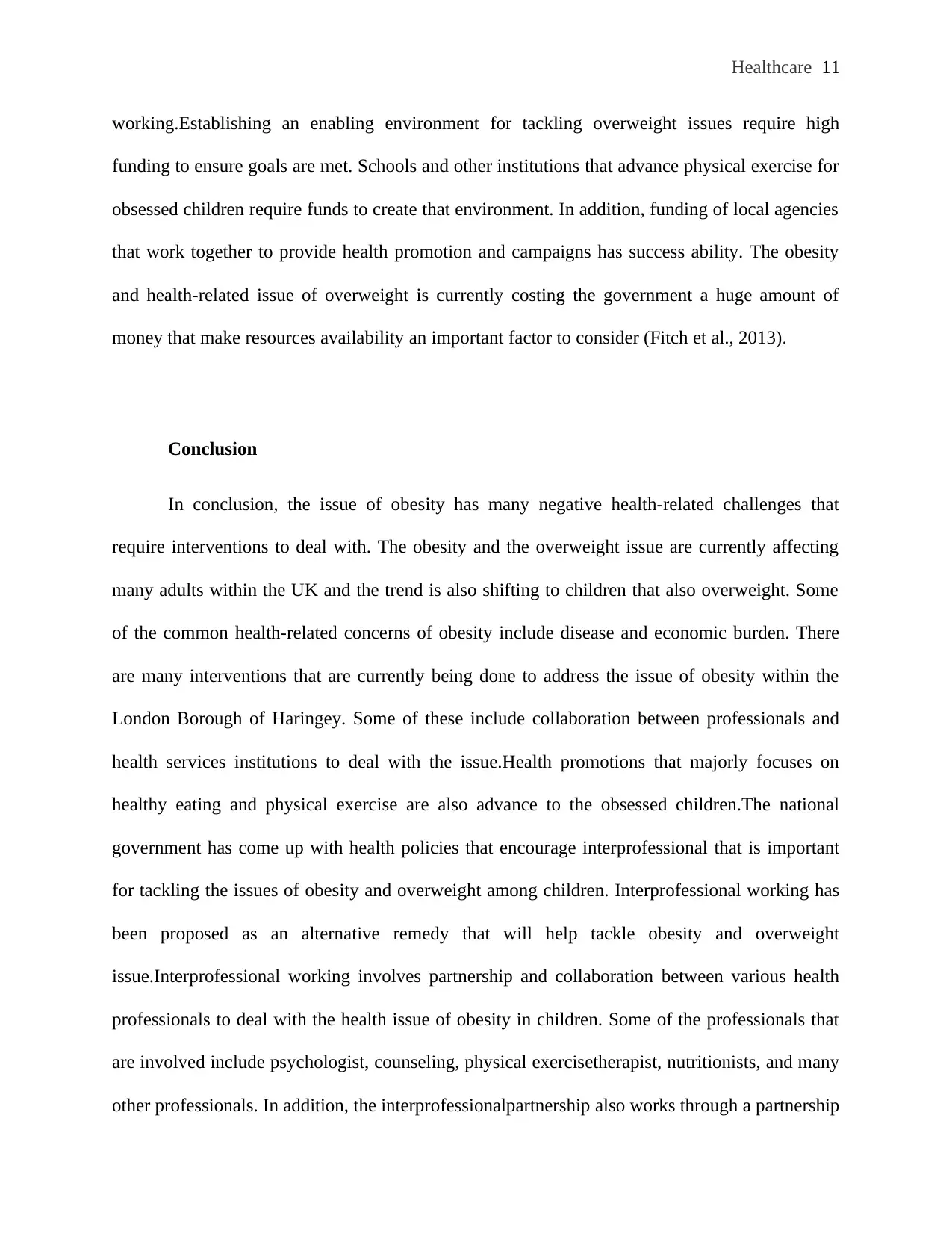
Healthcare 11
working.Establishing an enabling environment for tackling overweight issues require high
funding to ensure goals are met. Schools and other institutions that advance physical exercise for
obsessed children require funds to create that environment. In addition, funding of local agencies
that work together to provide health promotion and campaigns has success ability. The obesity
and health-related issue of overweight is currently costing the government a huge amount of
money that make resources availability an important factor to consider (Fitch et al., 2013).
Conclusion
In conclusion, the issue of obesity has many negative health-related challenges that
require interventions to deal with. The obesity and the overweight issue are currently affecting
many adults within the UK and the trend is also shifting to children that also overweight. Some
of the common health-related concerns of obesity include disease and economic burden. There
are many interventions that are currently being done to address the issue of obesity within the
London Borough of Haringey. Some of these include collaboration between professionals and
health services institutions to deal with the issue.Health promotions that majorly focuses on
healthy eating and physical exercise are also advance to the obsessed children.The national
government has come up with health policies that encourage interprofessional that is important
for tackling the issues of obesity and overweight among children. Interprofessional working has
been proposed as an alternative remedy that will help tackle obesity and overweight
issue.Interprofessional working involves partnership and collaboration between various health
professionals to deal with the health issue of obesity in children. Some of the professionals that
are involved include psychologist, counseling, physical exercisetherapist, nutritionists, and many
other professionals. In addition, the interprofessionalpartnership also works through a partnership
working.Establishing an enabling environment for tackling overweight issues require high
funding to ensure goals are met. Schools and other institutions that advance physical exercise for
obsessed children require funds to create that environment. In addition, funding of local agencies
that work together to provide health promotion and campaigns has success ability. The obesity
and health-related issue of overweight is currently costing the government a huge amount of
money that make resources availability an important factor to consider (Fitch et al., 2013).
Conclusion
In conclusion, the issue of obesity has many negative health-related challenges that
require interventions to deal with. The obesity and the overweight issue are currently affecting
many adults within the UK and the trend is also shifting to children that also overweight. Some
of the common health-related concerns of obesity include disease and economic burden. There
are many interventions that are currently being done to address the issue of obesity within the
London Borough of Haringey. Some of these include collaboration between professionals and
health services institutions to deal with the issue.Health promotions that majorly focuses on
healthy eating and physical exercise are also advance to the obsessed children.The national
government has come up with health policies that encourage interprofessional that is important
for tackling the issues of obesity and overweight among children. Interprofessional working has
been proposed as an alternative remedy that will help tackle obesity and overweight
issue.Interprofessional working involves partnership and collaboration between various health
professionals to deal with the health issue of obesity in children. Some of the professionals that
are involved include psychologist, counseling, physical exercisetherapist, nutritionists, and many
other professionals. In addition, the interprofessionalpartnership also works through a partnership
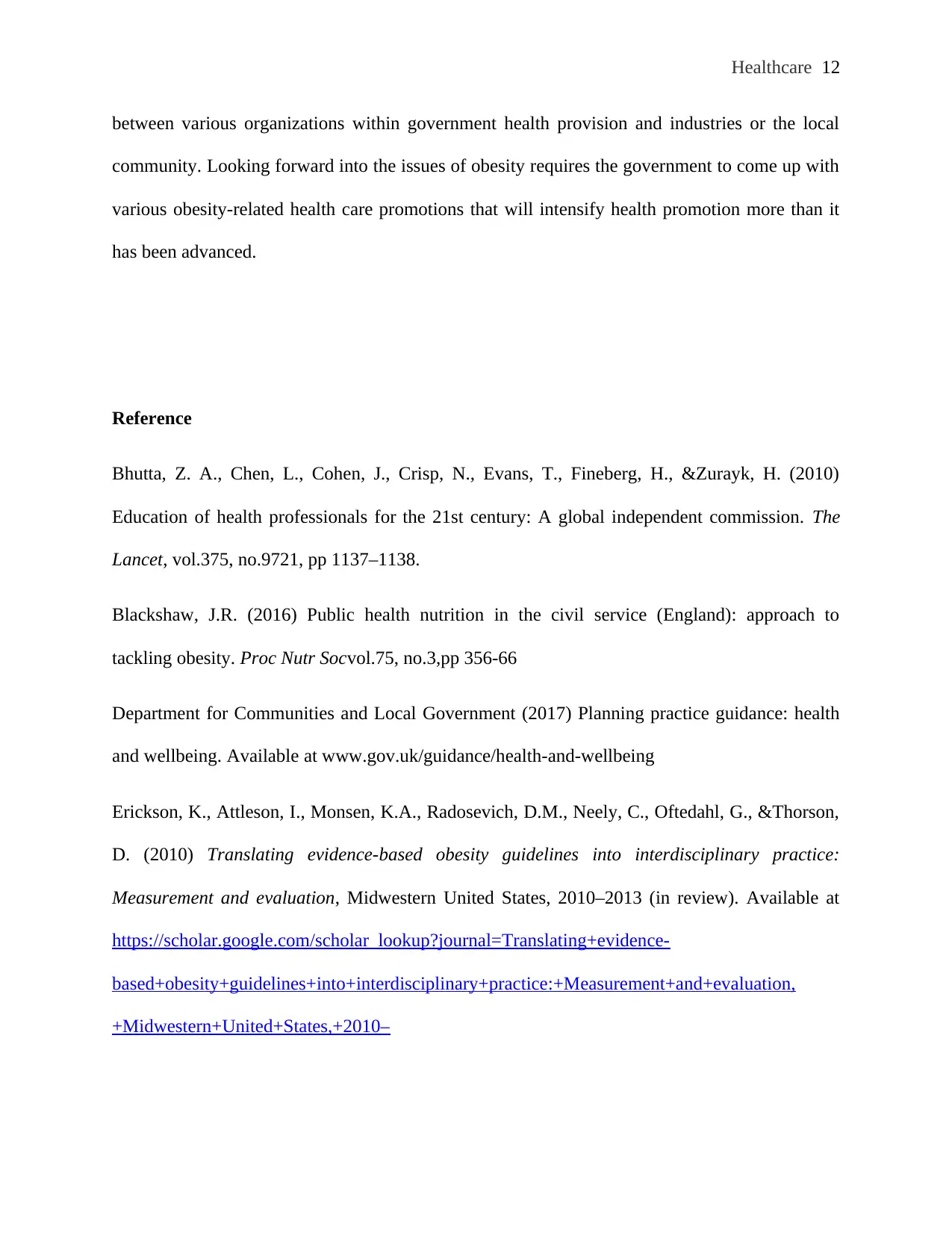
Healthcare 12
between various organizations within government health provision and industries or the local
community. Looking forward into the issues of obesity requires the government to come up with
various obesity-related health care promotions that will intensify health promotion more than it
has been advanced.
Reference
Bhutta, Z. A., Chen, L., Cohen, J., Crisp, N., Evans, T., Fineberg, H., &Zurayk, H. (2010)
Education of health professionals for the 21st century: A global independent commission. The
Lancet, vol.375, no.9721, pp 1137–1138.
Blackshaw, J.R. (2016) Public health nutrition in the civil service (England): approach to
tackling obesity. Proc Nutr Socvol.75, no.3,pp 356-66
Department for Communities and Local Government (2017) Planning practice guidance: health
and wellbeing. Available at www.gov.uk/guidance/health-and-wellbeing
Erickson, K., Attleson, I., Monsen, K.A., Radosevich, D.M., Neely, C., Oftedahl, G., &Thorson,
D. (2010) Translating evidence-based obesity guidelines into interdisciplinary practice:
Measurement and evaluation, Midwestern United States, 2010–2013 (in review). Available at
https://scholar.google.com/scholar_lookup?journal=Translating+evidence-
based+obesity+guidelines+into+interdisciplinary+practice:+Measurement+and+evaluation,
+Midwestern+United+States,+2010–
between various organizations within government health provision and industries or the local
community. Looking forward into the issues of obesity requires the government to come up with
various obesity-related health care promotions that will intensify health promotion more than it
has been advanced.
Reference
Bhutta, Z. A., Chen, L., Cohen, J., Crisp, N., Evans, T., Fineberg, H., &Zurayk, H. (2010)
Education of health professionals for the 21st century: A global independent commission. The
Lancet, vol.375, no.9721, pp 1137–1138.
Blackshaw, J.R. (2016) Public health nutrition in the civil service (England): approach to
tackling obesity. Proc Nutr Socvol.75, no.3,pp 356-66
Department for Communities and Local Government (2017) Planning practice guidance: health
and wellbeing. Available at www.gov.uk/guidance/health-and-wellbeing
Erickson, K., Attleson, I., Monsen, K.A., Radosevich, D.M., Neely, C., Oftedahl, G., &Thorson,
D. (2010) Translating evidence-based obesity guidelines into interdisciplinary practice:
Measurement and evaluation, Midwestern United States, 2010–2013 (in review). Available at
https://scholar.google.com/scholar_lookup?journal=Translating+evidence-
based+obesity+guidelines+into+interdisciplinary+practice:+Measurement+and+evaluation,
+Midwestern+United+States,+2010–
⊘ This is a preview!⊘
Do you want full access?
Subscribe today to unlock all pages.

Trusted by 1+ million students worldwide
1 out of 15
Related Documents
Your All-in-One AI-Powered Toolkit for Academic Success.
+13062052269
info@desklib.com
Available 24*7 on WhatsApp / Email
![[object Object]](/_next/static/media/star-bottom.7253800d.svg)
Unlock your academic potential
Copyright © 2020–2025 A2Z Services. All Rights Reserved. Developed and managed by ZUCOL.





